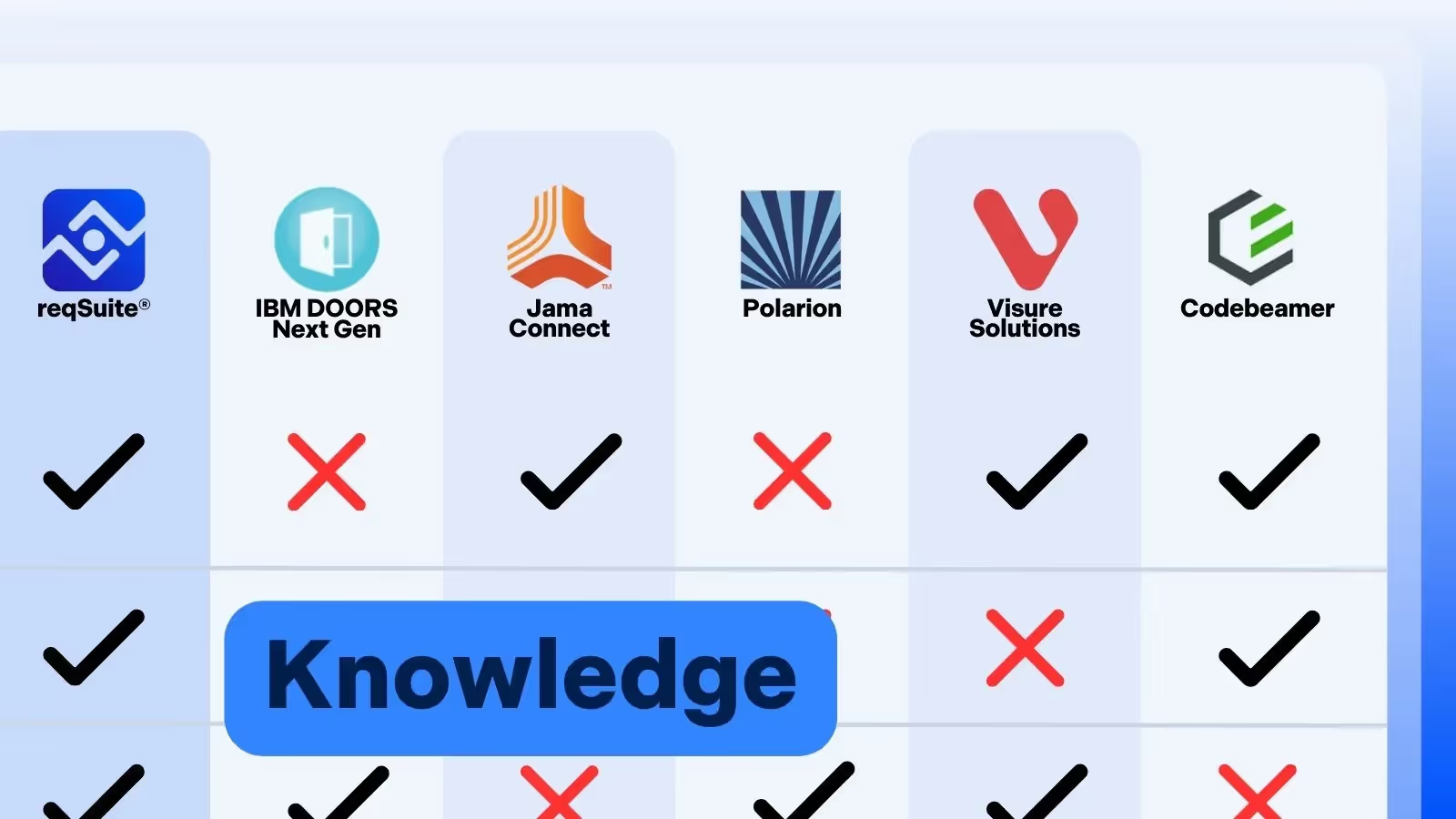
The best requirements management you've ever had.
Intuitive to use
Reliable in results
Efficient in processes

Find the tool that suits your projects, not the other way around.
Discover now how modern requirements management software can make your product development more efficient, secure and structured.
The Requirements Management Software That Professionals Trust: reqSuite® rm in Practice
2025-08-05
18
minutes reading time

An overview:
- Why requirements management is crucial today
Insight into the central role of requirements management in product development and why traditional tools such as Excel & Co. quickly reach their limits. - More than just documentation: what modern requirements management software needs to achieve
Traceability, quality assurance and team collaboration. How powerful tools such as reqSuite® rm create real productivity benefits. - Finding the right solution: Selection criteria from practice
Which functions really count, how to involve users early on and why the best software is the one that suits the team. - Structure creates quality – how good software improves product development
Why it's worth using, thanks to better product requirements, reliable tests and fewer frictional losses in day-to-day project work.
{{callout}}
Requirements management software: why it should be more than just a database
In complex development projects, success stands and falls with clear, structured and practiced requirements management. A suitable software solution is not just a tool, it is a decisive factor in systematically recording requirements, documenting them properly and developing them in a controlled manner throughout the entire course of the project.
Many companies start with simple means: Requirements are formulated in Word documents, collected in Excel spreadsheets or managed in a makeshift manner between e-mail processes and meetings. What seems flexible and quick at first glance quickly becomes a burden as the project progresses:
- Information is unstructured, difficult to find or available multiple times.
- Changes lead to uncertainty – nobody knows which version is current.
- There is a lack of traceability between requirements, test cases and architectural elements.
- There is no standardized procedure, no binding structure, everyone works according to their own logic.
- Important requirements are formulated too late or unclear, which makes subsequent corrections expensive.
We know from our many years of experience in research and consulting projects at Fraunhofer IESE: Many companies find it difficult to get started with requirements management. Traditional tools are often too complex, too technical or not sufficiently user-friendly. Although they offer many functions, they rarely support teams where it really matters in everyday life: with clear user guidance, the reusability of requirements and a practical introduction.
The logical consequence? To develop software that closes precisely this gap: reqSuite® rm. It should offer the advantages of modern requirements management tools such as traceability, version control, agile support and integration with other systems, but at the same time be intuitive, offer concrete assistance and support companies in sustainably improving their requirements process.
Note: Requirements management is the key to successful projects because it ensures that everyone involved is pursuing the same objectives and that requirements are implemented in a structured, comprehensible and controlled manner. Especially in complex or regulated projects, it helps to avoid errors, misunderstandings and expensive changes. Modern software solutions such as reqSuite® rm support this process efficiently – through traceability, version control, team collaboration and automatic quality checks.
What is requirements management and why is it so important?
Requirements management describes the structured process by which requirements in a project are collected, analyzed, documented, validated and managed throughout the entire lifecycle. The aim is to ensure that all stakeholders, from customers to developers to testing authorities, have a common understanding of what a project or product should achieve. At the same time, the project should always remain in line with these goals.
Well thought-out requirements management not only prevents misunderstandings, but also helps to identify risks at an early stage, implement changes in a controlled manner and minimize subsequent correction loops. Particularly in regulated industries, such as medical technology, mechanical engineering or software development, traceable and audit-proof requirements management is indispensable.
More than just lists and tables: How modern software supports everyday life
While many companies initially work with misappropriated tools such as Word or Excel, the added value of professional requirements management software quickly becomes apparent: it not only facilitates the recording and maintenance of requirements, but also makes correlations visible, promotes teamwork – and thus demonstrably increases quality and efficiency.
A look into practice: This is how reqSuite® rm supports everyday project work:
- Seamless traceability: All requirements can be fully linked to architecture components, standards, risks or test cases so that traceability is guaranteed at all times.
- Automatic impact analyses: As soon as a requirement is changed, the tool immediately shows which other requirements, test cases or people are affected. This saves time and prevents subsequent errors.
- Versioning at all levels: Changes to individual attributes are also recorded, so it is always possible to trace who changed what and when.
- Collaboration without chaos: The entire team works in a central system. No duplicate versions, no confusing email threads, just shared, traceable work in one place.
- Integrated review and comment functions: Comments and queries are placed directly on the affected requirements, including role and responsibility assignment.
- Reusability instead of rethinking: Requirements from previous projects can be reused in a structured manner, this not only increases efficiency, but also improves the quality of the specification.
- Intelligent quality checks: The software automatically detects unclear formulations, contradictions or missing content, before they become a problem in the project.
Note: Requirements management ensures that all project participants have a common understanding of the product objectives and that requirements are implemented in a structured, comprehensible and risk-minimizing manner. Modern software such as reqSuite® rm supports this process by systematically integrating traceability, collaboration, reusability and quality checks. This turns requirements into a reliable basis for successful projects.
Why requirements management software is indispensable today
In modern development projects, one thing is becoming increasingly clear. Anyone who does not manage requirements in a systematic and structured way risks costly errors, misunderstandings - and in the worst case scenario, the failure of the entire project. This is exactly where requirements management software comes in: it forms the central backbone for requirements engineering and ensures that requirements remain clear, consistent and complete throughout the entire project lifecycle.
More overview, less friction
Professional requirements management software not only supports the capture and documentation of requirements, but also accompanies the entire process: from analysis and prioritization to validation, approval and subsequent follow-up. This not only makes the entire handling of requirements more transparent, but also significantly more efficient.
Coordination with project participants is also simplified by central platforms – information is up-to-date, traceable and version-safe. This results in fewer queries, less chaos and more clarity within the team.
From the field: how quality and efficiency can be improved with the use of software
A satisfaction survey of all reqSuite® rm users showed impressively how much of an impact the introduction of the software has had on everyday life:
- Fewer errors at the beginning: The error rate in early project phases has dropped significantly because requirements are recorded in a more structured, complete and quality-assured manner.
- Fewer expensive subsequent changes: The number of late changes required, for example in the implementation phase, has been reduced by up to 30-50%.
- Time savings thanks to clear processes: Coordination and reviews cost up to 40% less time, as everyone involved works directly in the tool, traceable, up-to-date and commentable.
- Better traceability for stakeholders: Requirements can be checked and versioned at any time. This facilitates internal coordination as well as external audits.
- More reuse, less effort: Requirements that have already been specified can be reused intelligently, reducing the initial effort for new projects by an average of 50%.
- Measurably higher quality: Integrated checks, assistants and warning systems help to identify unclear or contradictory requirements at an early stage, before they become problems later on.
- Safe working – even without RE expertise: The software guides users through the requirements process and helps even less experienced employees to work in a structured and safe manner.
- Efficiency right through to downstream processes: Because the data is structured consistently, downstream work is also simpler e.g., in test case derivation or audits.
Note: Requirements management software is far more than just a documentation tool, it is a real productivity driver. It helps to avoid errors, save time and manage requirements in such a way that they remain comprehensible, verifiable and feasible for everyone involved. Companies that rely on this professional support not only increase their quality, but also their speed and create the basis for successful, economically viable projects.
What good requirements management software must do
Not every software that can capture and manage requirements is automatically suitable for professional use. Good requirements management software makes the difference, not through maximum functional density, but through practical support in everyday project work.
User guidance that thinks for itself
The best functions are useless if they are not used. That's why the focus is on user-friendliness: an intuitive interface, individually configurable input masks and role-based navigation ensure that even less experienced users can work productively and error-free.
Ensure traceability and quality
End-to-end traceability is also essential: it must be possible to seamlessly link requirements with architecture, test cases, standards or risks. Changes should be analyzed automatically including the impact on linked content. This is the only way to see what an adaptation actually means.
One user puts it in a nutshell: “The tool automatically recognizes when wording is unclear or information is missing, this saves us expensive errors in later phases.” Automatic quality checks and reuse options are also standard features of a strong solution today.
Flexibility and automation
A plus point for many teams: the ability to define rules for workflows, validations or alerts without any programming knowledge. This creates an active system that thinks for itself and ensures consistency in the background.
It is important that the software can be adapted to existing processes, not the other way around. This flexibility is a real productivity factor, especially with growing projects or growing companies.
Conclusion: Requirements management software as the key to successful product development
A professional tool for requirements management is no longer a nice-to-have. It is a decisive success factor in product development. It ensures that product requirements are not only documented centrally, but can also be comprehensibly linked to tests, standards and architecture modules. This creates clarity, avoids errors and increases quality right from the start.
The ability to link requirements with test cases and track them across all project phases is particularly valuable – for example during changes, validations or audits. A good software solution not only offers powerful functions, but also the necessary flexibility: for example, by connecting to other tools, importing and exporting via MS Office or role-based authorization concepts.
Investing in software for requirements management today lays the foundation for structured processes, less coordination effort and ultimately better products.
Would you like to make your product development more efficient, more secure and more structured?
Arrange a non-binding consultation with the experts at OSSENO now and find out whether reqSuite® rm is the right solution for your team.
About the author

Neele Borkowsky
Marketing Manager
Neele Borkowsky has been working as a marketing manager at OSSENO Software GmbH for almost three years and understands the challenges and uncertainties companies face when they have yet to adopt a requirements engineering solution. Through close interaction with prospects and customers across different industries, she knows what matters when choosing the right requirements management tool and the value that reqSuite® rm can provide.
Other interesting articles
.webp)
Tech
5
min. reading time
Release Notes reqSuite® rm 4.7

Phil Stüpfert
2025-12-12

Tech
3
min. reading time
reqSuite® rm – Interface to Isograph RWB & AttackTree

Neele Borkowsky
2025-12-10

Knowledge
10
min. reading time
Requirements Management Tools 2026: A Comparison for Medium Sized Product Developers

Neele Borkowsky
2025-12-08











